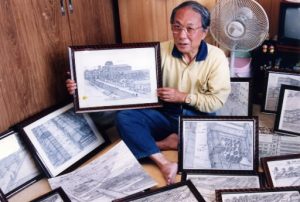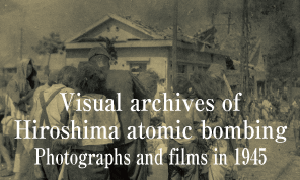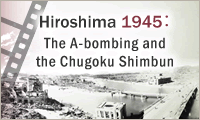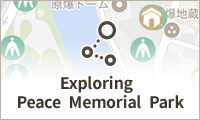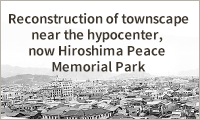Sarugaku-cho, neighborhood around A-bomb Dome, Part 2: With sense of mourning, drawings of memories made in pencil
Jul. 26, 1997
Visible in the area around the Hiroshima Prefectural Industrial Promotion Hall, the predecessor to the A-bomb Dome, are rows of traditional houses lining the streets with their lattice facades and rooftops used as spaces for drying clothes. At the east end of Motoyasu Bridge is a confectionery shop featuring a large Glico billboard that reads “One piece of candy provides enough energy to run 300 meters.” With a 5B pencil, the cityscape of that time has been meticulously recreated from a bird’s-eye view.
The drawings, created based on recollections of Shigeo Moritomi, 68, who lives in Inokuchi 4-chome in Hiroshima City’s Nishi Ward, evoke a bittersweet nostalgia for even those who do not know that time. “I used to run across rooftops and play until after sunset when I was a child,” said Mr. Moritomi. Warmly smiling from behind his glasses as he looked at the drawings, he added, “I wanted to revive the neighborhood in my own way, as a way of paying tribute.”
Mr. Moritomi’s parents managed the bedding shop called “Tsunetomo.” The shop was located in the area of 49 Saiku-machi, just east of Motoyasu Bridge, while their home address was 45 Sarugaku-cho. Both locations were less than 200 meters from the Industrial Promotion Hall. As a child, he lived in an exciting world that lay just within reach.
When he ran out of his house, the Motoyasu River was right in front of him. “In the summer, sailing boats from islands would pull up to the pier steps in front of the Dome and unload watermelons. I used to look forward to watching them fall and break open,” he said. The watermelons turned into snacks for the children, who would be sunbathing after exhausting themselves from swimming.
The Industrial Promotion Hall, with its spiral staircase, also served as a space for play, where movies featuring Charles Chaplin and Buster Keaton were shown. Across the streetcar tracks stood the vast Army’s West Drill Ground. In the fall, a sumo tournament would be held on the grounds of Gokoku Shrine, with recognizable local children being allowed to watch the event for free. They called the narrow path alongside a temple “ghost alley” and would chase chickens around the yard of Shima Hospital. The atomic bomb would later explode around 580 meters in the sky above that hospital.
Five months before the atomic bombing, Mr. Moritomi’s family had moved to the area of 19 Toriya-cho (present-day Ote-machi 2-chome, in Hiroshima’s Naka Ward), which was still within 500 meters of the hypocenter. His father, Shuichi, 42, his grandmother, Tome, 72, his younger brothers, Yasuo, 12, and Tamotsu, 10, as well as his late mother’s niece, 19, who was living with them, all died in the bombing.
At the time, Mr. Moritomi was a third-year student at Hiroshima Municipal Shipbuilding Engineering School (present-day Hiroshima Municipal Commercial High School) and experienced the atomic bombing while working as a mobilized student at a Mitsubishi factory in the city’s western area of Nishi Ward. After crawling out from beneath the collapsed wooden factory building, he headed for home through the raging flames.
“A young woman from the business Okamoto Miso in Sarugaku-cho, whose entire body had been burned, was in an air-raid shelter at Gokoku Shrine. Mr. Iwasaki, a young man called ‘Bocchan,’ who had treated us all so kindly, was curled up in front of the stairs of the Chamber of Commerce and Industry,” said Mr. Moritomi.
Because he was a poor speaker, he said he had avoided talking about his experience in the atomic bombing in public, even when asked to do so, but this time, he spoke about everything all at once. The bones found at the site where his house had been located could not be identified. The remains were then equally divided into five portions, including those of Yasuo, who, like Mr. Moritomi, attended Municipal Shipbuilding Engineering School and was missing after engaging in building-demolition work.
Two years later, he and his older brother, who had served in the military, once again erected the “Tsunetomo” sign on the east side of Motoyasu Bridge. “There were so few houses and people that we could hear announcements being made by microphone at Hiroshima Station,” he said. The atomic bombing had turned a neighborhood full of memories into the distant past.
Unable to draw details of “that day”
Mr. Moritomi began drawing the vanished neighborhood after he turned 60, a time he was managing a gift shop, partly because he hoped to pass on his experiences in the bombing to his son and daughter. He continued drawing and completed 35 pieces, stopping three years ago, when he underwent surgery to remove the lens of his right eye.
However, he only managed to draw a few scenes of the neighborhood on “that day,” August 6, 1945. Unlike his detailed depictions of the pre-war period, people in these drawings were extremely simplified. He said he “couldn’t possibly draw them.” He hesitated to depict things as they were, precisely because he had been there at the time. He found himself unable to draw details.
(Originally published on July 26, 1997)
The drawings, created based on recollections of Shigeo Moritomi, 68, who lives in Inokuchi 4-chome in Hiroshima City’s Nishi Ward, evoke a bittersweet nostalgia for even those who do not know that time. “I used to run across rooftops and play until after sunset when I was a child,” said Mr. Moritomi. Warmly smiling from behind his glasses as he looked at the drawings, he added, “I wanted to revive the neighborhood in my own way, as a way of paying tribute.”
Recreating world that once made his heart race
Mr. Moritomi’s parents managed the bedding shop called “Tsunetomo.” The shop was located in the area of 49 Saiku-machi, just east of Motoyasu Bridge, while their home address was 45 Sarugaku-cho. Both locations were less than 200 meters from the Industrial Promotion Hall. As a child, he lived in an exciting world that lay just within reach.
When he ran out of his house, the Motoyasu River was right in front of him. “In the summer, sailing boats from islands would pull up to the pier steps in front of the Dome and unload watermelons. I used to look forward to watching them fall and break open,” he said. The watermelons turned into snacks for the children, who would be sunbathing after exhausting themselves from swimming.
The Industrial Promotion Hall, with its spiral staircase, also served as a space for play, where movies featuring Charles Chaplin and Buster Keaton were shown. Across the streetcar tracks stood the vast Army’s West Drill Ground. In the fall, a sumo tournament would be held on the grounds of Gokoku Shrine, with recognizable local children being allowed to watch the event for free. They called the narrow path alongside a temple “ghost alley” and would chase chickens around the yard of Shima Hospital. The atomic bomb would later explode around 580 meters in the sky above that hospital.
Five months before the atomic bombing, Mr. Moritomi’s family had moved to the area of 19 Toriya-cho (present-day Ote-machi 2-chome, in Hiroshima’s Naka Ward), which was still within 500 meters of the hypocenter. His father, Shuichi, 42, his grandmother, Tome, 72, his younger brothers, Yasuo, 12, and Tamotsu, 10, as well as his late mother’s niece, 19, who was living with them, all died in the bombing.
At the time, Mr. Moritomi was a third-year student at Hiroshima Municipal Shipbuilding Engineering School (present-day Hiroshima Municipal Commercial High School) and experienced the atomic bombing while working as a mobilized student at a Mitsubishi factory in the city’s western area of Nishi Ward. After crawling out from beneath the collapsed wooden factory building, he headed for home through the raging flames.
“A young woman from the business Okamoto Miso in Sarugaku-cho, whose entire body had been burned, was in an air-raid shelter at Gokoku Shrine. Mr. Iwasaki, a young man called ‘Bocchan,’ who had treated us all so kindly, was curled up in front of the stairs of the Chamber of Commerce and Industry,” said Mr. Moritomi.
Because he was a poor speaker, he said he had avoided talking about his experience in the atomic bombing in public, even when asked to do so, but this time, he spoke about everything all at once. The bones found at the site where his house had been located could not be identified. The remains were then equally divided into five portions, including those of Yasuo, who, like Mr. Moritomi, attended Municipal Shipbuilding Engineering School and was missing after engaging in building-demolition work.
Two years later, he and his older brother, who had served in the military, once again erected the “Tsunetomo” sign on the east side of Motoyasu Bridge. “There were so few houses and people that we could hear announcements being made by microphone at Hiroshima Station,” he said. The atomic bombing had turned a neighborhood full of memories into the distant past.
Unable to draw details of “that day”
Mr. Moritomi began drawing the vanished neighborhood after he turned 60, a time he was managing a gift shop, partly because he hoped to pass on his experiences in the bombing to his son and daughter. He continued drawing and completed 35 pieces, stopping three years ago, when he underwent surgery to remove the lens of his right eye.
However, he only managed to draw a few scenes of the neighborhood on “that day,” August 6, 1945. Unlike his detailed depictions of the pre-war period, people in these drawings were extremely simplified. He said he “couldn’t possibly draw them.” He hesitated to depict things as they were, precisely because he had been there at the time. He found himself unable to draw details.
(Originally published on July 26, 1997)

